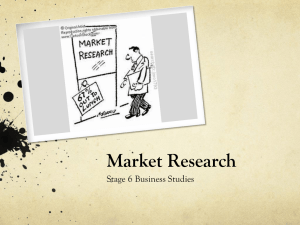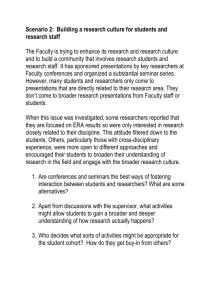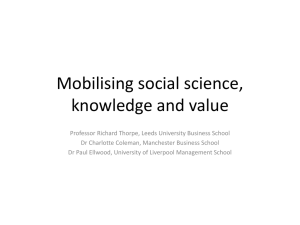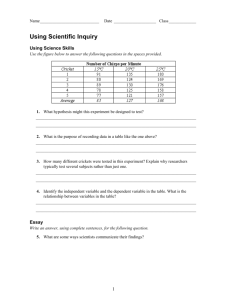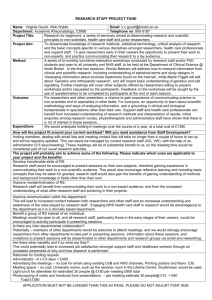Empirical research in business administration has been criticized for
advertisement
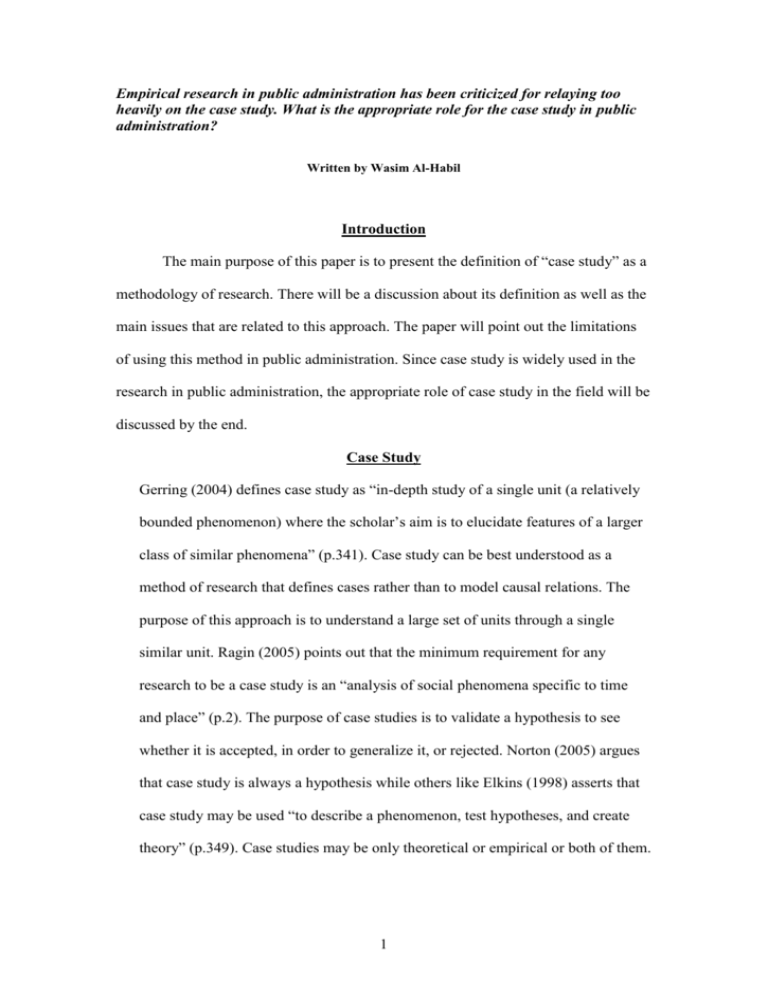
Empirical research in public administration has been criticized for relaying too heavily on the case study. What is the appropriate role for the case study in public administration? Written by Wasim Al-Habil Introduction The main purpose of this paper is to present the definition of “case study” as a methodology of research. There will be a discussion about its definition as well as the main issues that are related to this approach. The paper will point out the limitations of using this method in public administration. Since case study is widely used in the research in public administration, the appropriate role of case study in the field will be discussed by the end. Case Study Gerring (2004) defines case study as “in-depth study of a single unit (a relatively bounded phenomenon) where the scholar’s aim is to elucidate features of a larger class of similar phenomena” (p.341). Case study can be best understood as a method of research that defines cases rather than to model causal relations. The purpose of this approach is to understand a large set of units through a single similar unit. Ragin (2005) points out that the minimum requirement for any research to be a case study is an “analysis of social phenomena specific to time and place” (p.2). The purpose of case studies is to validate a hypothesis to see whether it is accepted, in order to generalize it, or rejected. Norton (2005) argues that case study is always a hypothesis while others like Elkins (1998) asserts that case study may be used “to describe a phenomenon, test hypotheses, and create theory” (p.349). Case studies may be only theoretical or empirical or both of them. 1 Case study may be found in a positive, critical theory, or interpretive research method. According to Tellis (1997), case study can be exploratory, explanatory, or descriptive. The exploratory case studies start the fieldwork and the collection of data before defining the hypothesis or the research question. Case study can be explanatory when it focuses on causal studies, especially in complex and multivariate cases. It also can be descriptive when the researchers start their investigations with a descriptive theory. This type of case studies presents the hypotheses of cause-effect relationships. Case study may be employed to study a small or a large (N). For instance, studying public administration in the United States may focus on the whole administration as a unity in one case study and deal with it as a single case. On the other hand, a study may focus on the different branches or departments, within the public administration, which have different roles and huge interrelationships. Even though this (N) is large because it contains a large number of units, it is considered only as one case in this study. This case study is considered multiple-cases that present a unity of one case study. Case study may also concentrate on studying one individual. Case studies that focus on one or few units are justified because it is easier, sometimes, to understand the whole picture by seeing a single element rather than many elements. Lieberson (2005) argues that large (N) is preferable than small one under specific circumstances. He thinks that “small-N studies cannot operate effectively under probabilistic assumption, because then they would require much larger N’s to have any meaningful results” (Lieberson, 2005, 109). Whatever the size of (N) is, the most important point is that the unit/s of (N) under study must be bounded. Also, Tellis (1997) insists that 2 case study research is not sampling research, which is a fact that all major researchers in this topic assert. Gerring (2004) points out that there are some characteristics that make case study useful when it is used in some types of research more than others. First of all, case study raises the question about whether the type of inference in this approach is descriptive or causal. Indeed, case study is connected with descriptive inference by a methodological affinity. Although case study may be less problematic when it is used in causal research, the most famous case studies are descriptive in orientation. These case studies focus on What? And How? Questions rather than Why? questions. Therefore, a simple descriptive case study searches whatever the unit under study is alike or unlike to similar units. This implies that a case study describe a phenomena in comparison to an ideal definition. Describing the differences relies on language to categorize units into identifiable entities. Based on this, language has a critical role to set the laws that guide case study in describing any phenomena. Gerring (2004) asserts that this argument does not mean that case study cannot be used in causal research, but the main point is that “it is easier to conduct descriptive work than causal propositions while working in a case study mode” (p.347). Second, case study works better when the purpose considers the depth more than the width of any research. However, Gerring (2004) argues that because of the limited width, “case studies often produce inferences with poorly defined boundaries” (p.347). On the other hand, case study is the best tool which offers a depth analysis of a phenomenon. This depth is based on the high degree of “the detail, richness, completeness, wholeness, or degree of variance that is accounted for by any explanation” (Gerring, 2004, 348). 3 In addition, Gerring (2004) thinks that social science has focused on testing existing theories rather than creating new ones. This is because creating new theories implies a dismissed matter of guesswork and stimulation which reflects a poor subject to focus on in case study. This approach tends to confirm or disconfirm a phenomenon through a new theory. Since research in social sciences is rigorous and seminal work, case studies “enjoy a natural advantages in research of an explanatory nature” (Gerring, 2004, 349). In sum, case study, according to Gerring (2004), works better in explanatory research more than in confirmatory one. Case study may be conducted in either quantitative or qualitative mode. Platt (2005) asserts that case study is used in practice to build good arguments, however it is chosen, analyzed, generalized, or presented. In other words, the main point in case study is not whether it uses a qualitative or quantitative method, but whether it is a convincing argument for its audiences. The main matter that determines what mode of research fits better into a case study to make it more effective depends on the nature of the population (N). According to Platt (2005), the “only theoretical concern has been that the sample should be representative of a population” (p.42). In public organizations, researchers may interview one manager in the high administrative level or conduct a survey on many managers in the mid administrative level. Whatever the sample is, an individual or a group of people, it is acceptable to represent the population since it has a strong representation. In other words, different qualitative or quantitative methods such as observations or surveys, can lead to a strong case study which implies an acceptable generalization of its conclusion. Case study also, according to Platt (2005), can be an empirical research that focuses on an issue in the past or the present. This means that a case study in public administration can explore an event that happened in the past, like the tax reform act 4 in 1986 or a recent issue such as the social security. Gerring (2004) asserts that case study examines events over the time in its historical context. Thus, a phenomenon is studied before, during, and after an event to see what kind of change happened. In public administration for instance, a case study about the tax reform act of 1986 focuses on the conditions and events that happened before the tax reform and led the administration to act. It also focuses on the political conditions that made both major political parties agree on this reform during the discussion in the Congress. And this case study also explores what was changed and what remained the same after this reform and whether it had positive or negative effects on public administration/finance. Abbott (2005) points out the importance of case study as a narrative story. Case study is a narrative storytelling that researchers try to convince an audience with. The role of researchers in this method is to explore people and events as neutral as possible. However, the experiences of the researchers definitely shape this narrative research. Case study may start with a description of data, but it turns to a narrative analysis of this data. The narrative approach is considered an advantage when the research focuses on understanding the behavior of human beings. Therefore, researchers tell their story of how to reach their conclusions and findings, then they leave the audience to decide whether they accept this case or not. The audience can decide if any case study is applicable or useful for them or not even if the case talks about an individual. Case study that focuses on an individual can be useful for other individuals that have the some shared conditions as in the case. The validity of the findings of case study is a little debatable. Walton (2005) points out that talking about an event of a condition differs from when a researcher talks about a case because it has a sense of generality. Generalizations, as Walton 5 (2005) argues, in “social sciences are developed from case-study methods… we progress from limited to more general interpretations of causal processes through reformulations of the case” (p.126). However, others believe that the external validity of case study is one of the obvious weaknesses that this approach has. Case Study in Public Administration Case study can be a good research method to be used in public administration. However, there are some limitations that may decrease the effectiveness that this type of research can offer the field of public administration. This part of the paper sorts these limitations into two groups. The first group focuses on the theoretical limitations of case study that face researchers, while the second group discusses the practical limitations of this method that face the administrators in pubic sector. The appropriate role of the case study in public administration will appear through the discussion, with the consideration to avoid these limitations in order to have effective case studies in the field. In terms of the theoretical limitations that case study has, it requires much effort to collect and analyze the data. According to O’Sullivan & Gary (1999), the huge requirements of time, experience, energy, and maybe money discourage this kind of research. Especially in multiple-case studies, researchers find themselves with limited skills in the variety of research techniques which are used in the case study. Therefore, many researchers often find that conducting a case study “is impractical because of the effort required” (O’Sullivan & Gary, 1999, 39). In addition, the legitimacy of the case study approach as a source of the scientific knowledge is questionable. Elkins (1998) argues that this view usually compares case study to the natural science methodology which is based on the 6 mathematical procedures of positivism. The role of the researchers in shaping their research is a critical point that case study is criticized for. It is believed that the researchers that use the case study approach cannot detach themselves from their findings. In other words, their findings are always subjective rather than objective. Moreover, case study is criticized through the lacks of the internal and external validity of this research method. Elkins (1998) discusses how some researchers think that case study entirely has no control to have a scientific value. This view believes that case study is an inferior form of scientific logic of inquiry. The external validity of case study, especially, is very problematic because many researchers doubt the ability of a case study to generalize its findings. White (1999) criticized case study because of the “validity of this type of research [which] need to be improved” (p.184). Finally, case study is attacked because of its doubtable ability to reproduce the results of an experiment, or what is called replication. Since the researcher in the case study approach involve in the research, which produce subjective results, the replication of the same work by others would be hard if not impossible. Elkins (1998) supports this point by referring to “the most frequent and specific critique of case studies is that they are vulnerable to research bias” (p.351). In general, some researchers such as White (1999) criticize case study because “it lacks a strong theoretical framework and a widely understood philosophical foundation” (p.4). In terms of the practical limitations that administrators may face when they try to apply case study in the real settings, O’Sullivan & Gary (1999) think that the wide need of information, which case study requires, is a problematic issue. Case study needs depth and detailed information, in addition to the appropriate technique, to reach accurate findings. This requirement is often not met when practitioners in public 7 administration face a problem that needs to be solved under the restrictions of time, cost, and authority. O’Sullivan & Gary (1999) argues that “the administrators find that they and their staff lack both the training and time needed to do effective case studies” (p.38). Furthermore, many case studies that were done in public administration are focused on limited individual units under study to analyze. This implies that the case studies which do not offer a whole clear picture for the practitioners will depend on the capability of these practitioners to use their own experiences. In other words, there is a doubt that the case studies that are produced by researchers are not completely useful for administrators. O’Sullivan & Gary (1999) states that “administrators’ direct experience with case studies may be limited to their professional reading” (p.39). As a final point, case study faces a serious challenge when it works in real settings to analyze public programs. In fact, the case study approach should be handled with extra care when it deals with practical situations to give a specific assessment. This means that a case study research that is prepared to be published differs from the case study which is needed to fix a real problem in the public sector. There should be a critical concentration on the issues that are related to the design of the case study and the proper techniques that should be used. O’Sullivan & Gary (1999) believe that “inappropriately defined case can be as a case without predetermined criteria for judging whether a hypothesis is supported” (p.40). The appropriate role of case study in public administration is the role that takes in consideration all these theoretical and practical limitations which decrease the efficiency of using this method in the field. The appropriate case study in public administration is the one that promotes the theoretical abilities of researchers and the practical needs of administrators. This role can be accomplished, for instance, through 8 giving an equal opportunity of teaching the different qualitative and quantitative research methods in the academic programs of public administration. Learning case study should be focused “to equipping future scholars with its logic, methods, and techniques” (White, 1999, 185). Also, this role of case study can be reached through paying more attention to the rigor of this research method. Case study can gain much respect in the field if all researchers, who conduct case studies, follow a sort of specific scientific methods in their research as Yin (1994) presents in his work, for instance. References Abbott A. (2005). What do cases do? Some notes on activity in sociological analysis. In C. C. Ragin, & H. S. Becker (Eds.), What is a case, exploring the foundations of social inquiry. (pp. 53-82). New York, NY: Cambridge University Press. Elkens D. (1998). Case Study. In International encyclopedia of public policy and administration. J. Shafrits (Ed). (Vol. 1, pp. 349-352). Boulder: Westview Press. Gerring, J. (2004). What is a case study and what is it god for?. American Political Science Review. Vol. 98. No. 2. 341- 354. Lieberson S. (2005). Small N’s and big conclusions: an examination of the reasoning in comparative studies based on a small number of cases. In C. C. Ragin, & H. S. Becker (Eds.), What is a case, exploring the foundations of social inquiry. (pp. 105-118). New York, NY: Cambridge University Press. O’Sullivan E., & Gary R. R. (1999). Research method of publicadministration. New York: Addison Wesley Longman, Inc. 9 Platt J. (2005). Cases of cases… of cases. In C. C. Ragin, & H. S. Becker (Eds.), What is a case, exploring the foundations of social inquiry. (pp. 21-52). New York, NY: Cambridge University Press. Ragin C. C. (2005). Introduction: cases of “what is a case?”. In C. C. Ragin, & H. S. Becker (Eds.), What is a case, exploring the foundations of social inquiry. (pp. 117). New York, NY: Cambridge University Press. Tellis W. (1997) Introduction to case study. The Qualitative Report. Vol. 3. Retrieved May 1, 2005, from http://www.nova.edu/ssss/QR/QR3-2/tellis1.html Walton (2005). Making the theoretical case. In C. C. Ragin, & H. S. Becker (Eds.), What is a case, exploring the foundations of social inquiry. (pp. 121-137). New York, NY: Cambridge University Press. White, J. D. (1999). The narrative foundations of publicadministration research. Washington, DC: Georgetown University Press. Yin R. K. (1994). Case study research, design and methods. Thousand Oaks, California: SAGE Public/publications, Inc. 10
